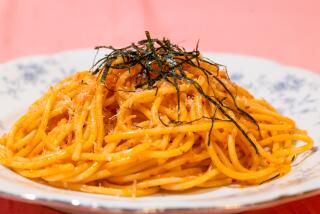Asian Pasta: Great Way to Use Your Noodle
- Share via
For anybody who hasn’t had the job of writing a weekly column about food (or any other subject), it’s probably hard to imagine how hard it can be to find new and interesting subjects. But today’s inspiration simply came from lunch--a wonderful concoction of noodles, peanut sauce and cucumber slices from a vegetarian Chinese restaurant.
Discovering Asian noodles can be a pleasant surprise to Western cooks. While the noodles don’t offer outstanding nutrient value, they can easily be used in some great low-fat dishes that add variety to your family meals.
The labeling of Asian noodles has been tricky. Originally, the U.S. Food and Drug Administration ruled that in order to be called “macaroni” or “noodles,” a product must contain one or more specific ingredients such as semolina, farina, durum wheat flour and eggs. Because most Asian noodles are made of other ingredients, the FDA required them to be called “imitation noodles” or “alimentary paste,” neither of which sounds particularly appetizing. Regulations have since been relaxed, allowing them be called “Asian noodles.”
Fresh Asian pasta (like Western pasta) is perishable and should be refrigerated or frozen when you take it home. Be sure to check the “sell by” date. You can store the pasta in the refrigerator for a day or two, and it can be frozen for about three months if tightly wrapped in plastic. Fresh rice noodles become stiff when cold, so they are often sold at room temperature, and keep that way for a day or two.
Dried noodles keep for months, but store them in an airtight container. Leftovers will stay fresh a day or two in the refrigerator.
The same types of noodles are used throughout Asia, but often have different names.
Bean thread noodles
Chinese: fen si, fun sie; Japanese: sarifun, harusame; Korean: dang myun; Vietnamese: bun tau.
These mung bean flour noodles are semi-translucent and turn clear when cooked. Easy to stir-fry or braise, they are almost pure starch and have few nutrients besides iron.
Buckwheat noodles
Chinese: qiao mian; Japanese: soba; Korean: naeng myun.
These flat, gray noodles of buckwheat and wheat flour are rich in protein and often are served in a broth or chilled, with a dipping sauce.
Egg noodles
Chinese: dan mian, don mein.
These wheat and egg noodles are much like the egg noodles you are probably used to. In Asian recipes, they are added to soup, topped with meat or sesame sauce or eaten cold, maybe with a dressing of oil and some flavored sauce.
Rice noodles
Chinese: sha he fen, sao ho fun, gan he fen, gon ho fun; Vietnamese: uot, banh pho.
Rice noodles are usually sold dried and coiled in plastic bags. They can be very thin (threads) or about the thickness of spaghetti, and are typically boiled or stir-fried in salads and soups.
Familiar to anyone who enjoys dim sum (Chinese brunch), fresh rice noodles are often rolled into sheets and made into dumplings. Like noodles made from beans, they are almost entirely starch, are low in protein and have few other nutrients.
Wheat noodles
Chinese: gan mian, sun mian; Japanese: somen, udon, ramen; Korean: mil gougsou; Vietnamese: mi soi.
Non-egg wheat noodles come in as many shapes and sizes as Western pasta and are similar nutritionally (except for more sodium). The two most popular in the United States are udon (thick and chewy and usually served in broth) and somen, usually very thin and often eaten cold. Wheat noodles also show up in chow mein and lo mein dishes.
A note of caution about packaged Asian noodles: The noodles in those familiar ramen dishes added to boiling water are deep-fried, which leaves them with a huge residue of fat, often highly saturated. To make matters worse, the seasoning packages are often high in sodium. And those crispy “chow mein noodles” sold in cans are also deep fried in hydrogenated vegetable oil (237 calories and 14 grams of fat in a mere 1 1/2 ounce).
Here’s a favorite recipe for a healthy soup that comes from “The Wellness Low-fat Cook Book” (Rebus, 1993).
Miso Chicken Soup With Rice Noodles
4 dried shiitake mushrooms soaked for 30 minutes in a cup of warm water
4 cups low-sodium, low-fat chicken stock
1 ounce dried rice noodles
1/4 cup miso (a soy-based seasoning paste used in Japanese cooking)
6 ounces skinless, boneless chicken breast, cut into very thin strips
1/2 cup lightly packed spinach or bok choy leaves, torn into small pieces
1/8 teaspoon sesame oil
Strain the mushroom-soaking liquid into a medium saucepan. Add the stock and bring to a boil. Cut off and discard the mushroom stems. Cut the caps into slivers and add them to the stock along with the rice noodles and simmer 3 to 4 minutes.
Remove about 1/4 cup of the stock and combine with miso in a small bowl. Mix well and add to the soup. Add the chicken strips and bring just to a boil. Add the spinach, remove the pan from the heat and stir in the sesame oil.
Makes 4 servings, each with 137 calories, 2 grams of fat, 24 mg of calcium and 458 mg potassium.
More to Read
Eat your way across L.A.
Get our weekly Tasting Notes newsletter for reviews, news and more.
You may occasionally receive promotional content from the Los Angeles Times.










